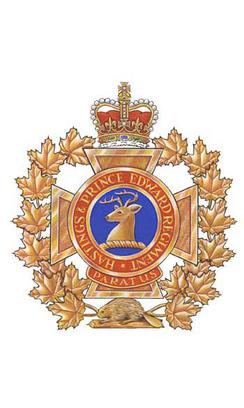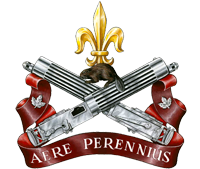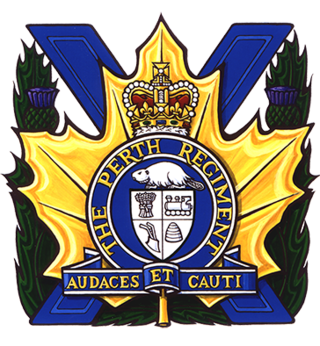
The Nova Scotia Highlanders is an infantry regiment in the primary reserve of the Canadian Army. It is part of 36 Canadian Brigade Group, 5th Canadian Division.

The Hastings and Prince Edward Regiment is a Primary Reserve infantry regiment of the Canadian Army. The regiment is part of 33 Canadian Brigade Group, one of four brigade groups of 4th Canadian Division. The regimental headquarters and one company are at 187 Pinnacle Street in Belleville and on Willmott Street in Cobourg, with another rifle company in Peterborough. The Peterborough Armoury houses what was traditionally B Company or Moro Company. Moro Company also serves as the headquarters for the regiment’s Assault Pioneer Platoon. Normally, the regiment deploys as a composite, Ortona Company, while the headquarters and administration form Somme Company.

The Régiment de la Chaudière is a Primary Reserve infantry regiment of the Canadian Army. It is part of the 2nd Canadian Division's 35 Canadian Brigade Group and is headquartered at Lévis, Quebec.

The North Saskatchewan Regiment is a Primary Reserve infantry regiment of the Canadian Army, headquartered in Saskatoon, Saskatchewan, with companies in Saskatoon and Prince Albert. Its current commanding officer is Lieutenant-Colonel Mike Graver, and the Regimental Sergeant-Major is Chief Warrant Officer Jason Balcaen. The N Sask R is part of the 3rd Canadian Division's 38 Canadian Brigade Group, with the regiment's mission task as of 2024 being to provide direct fire support.

The Royal Regina Rifles is a Primary Reserve infantry regiment of the Canadian Army. Prior to 1982 the regiment was known as The Regina Rifle Regiment. The Royal Regina Rifles are part of 3rd Canadian Division's 38 Canadian Brigade Group.

The Irish Regiment of Canada is a Primary Reserve infantry regiment of the Canadian Army based in Sudbury, Ontario. It is part of the 4th Canadian Division's 33 Canadian Brigade Group. Currently one battalion of the regiment exists.
The Prince Albert Volunteers (PAV) is the name of two historical infantry units headquartered in Prince Albert, Saskatchewan. The unit was first raised in 1885 during the North-West Rebellion and disbanded after hostilities ceased. In the 20th century, the unit was operational from 1913 to 1936 and 1941 to 1946. The PAV is now incorporated by amalgamation in the North Saskatchewan Regiment (N Sask R).

The Perth Regiment was an infantry regiment of the Canadian Army. It is currently on the Supplementary Order of Battle.

The Highland Light Infantry of Canada was an infantry regiment of the Canadian Army. In 1965, the regiment was amalgamated with The Scots Fusiliers of Canada to form The Highland Fusiliers of Canada.
The Winnipeg Light Infantry was an infantry regiment of the Non-Permanent Active Militia of the Canadian Militia. In 1955, the regiment was amalgamated with The Royal Winnipeg Rifles.
The Edmonton Fusiliers was an infantry regiment of the Non-Permanent Active Militia of the Canadian Militia and later the Canadian Army. First raised in 1908 as part of the 101st Regiment Edmonton Fusiliers, it became a separate regiment in 1924 when The Edmonton Regiment was split into two separate regiments. In 1946, the regiment was Amalgamated with the 19th Alberta Dragoons.
The Carleton and York Regiment was an infantry regiment of the Non-Permanent Active Militia of the Canadian Militia. In 1954, the regiment was amalgamated with The New Brunswick Scottish and The North Shore Regiment to form the two battalions of The New Brunswick Regiment.
The Canadian Fusiliers (City of London Regiment) was an infantry regiment of the Non-Permanent Active Militia of the Canadian Militia (now the Canadian Army). In 1954, the regiment was amalgamated with the Oxford Rifles to form the London and Oxford Fusiliers (now the reserve battalion of the Royal Canadian Regiment).
The 53rd Battalion, CEF, was an infantry battalion of the Canadian Expeditionary Force during the Great War. The 53rd Battalion was authorized on 7 November 1914 and embarked for Great Britain on 29 March 1916. It provided reinforcements for the Canadian Corps in the field until it was disbanded on 12 October 1917.
The 16th/22nd Saskatchewan Horse was a cavalry regiment of the Non-Permanent Active Militia of the Canadian Militia. The regiment was formed in 1936, when the 16th Canadian Light Horse was amalgamated with The Saskatchewan Mounted Rifles. After a number of changes, the regiment now forms part of The North Saskatchewan Regiment.
The Dufferin and Haldimand Rifles of Canada was an infantry regiment of the Non-Permanent Active Militia of the Canadian Militia and later the Canadian Army. The regiment was formed in 1936, when The Haldimand Rifles was Amalgamated with The Dufferin Rifles of Canada. In 1946, the regiment was converted from Infantry to Artillery and now forms part of the 56th Field Artillery Regiment, RCA.
The Saint John Fusiliers was an infantry regiment of the Non-Permanent Active Militia of the Canadian Militia. In 1946, the regiment was amalgamated with The New Brunswick Rangers to form the South New Brunswick Regiment which was later renamed as The New Brunswick Scottish. They now form part of the 1st Battalion, The Royal New Brunswick Regiment.
The Colchester and Hants Regiment was an infantry regiment of the Non-Permanent Active Militia of the Canadian Militia. In 1936, it was amalgamated with The Cumberland Highlanders to create The North Nova Scotia Highlanders.
The North Saskatchewan Regiment was a short-lived infantry regiment of the Non-Permanent Active Militia of the Canadian Militia. In 1924, the regiment was reorganized and split up into 4 separate regiments.
The Midland Regiment was an infantry regiment of the Non-Permanent Active Militia of the Canadian Militia and later the Canadian Army. The regiment was formed in 1936 by the Amalgamation of The Northumberland Regiment and The Durham Regiment. In 1954, The Midland Regiment was amalgamated into The Hastings and Prince Edward Regiment.







